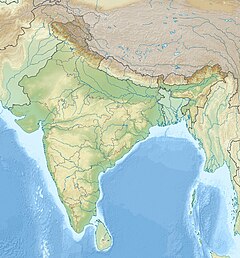The Ahar River is a tributary of the Berach River which drains to Banas River. The Banas River, in turn, is a tributary of the Chambal river, which eventually drains to the Yamuna River. The Yamuna River is the principal tributary of Ganges River, making the Ahar River part of the extensive network that contributes to the Ganges basin.
| Ahar River | |
|---|---|
 | |
| Location | |
| Country | India |
| States | Rajasthan and Uttar Pradesh |
| Cities | |
| Physical characteristics | |
| Source | Aravalli range |
| • location | Udaipur, Mewar, Rajasthan, India |
| • coordinates | 24°34′N 73°48′E / 24.567°N 73.800°E |
| Mouth | Ahar-Berach sangam confluence |
• location | Madhya Pradesh, India |
| Basin features | |
| Progression | Ahar River, Berach River, Banas River, Chambal river, Yamuna River, Ganges River |
| River system | Ganges |
The river flows through the Udaipur city and is its larger drainage body. The spill water of the famous Lake Pichola and Fateh Sagar Lake of Udaipur district gets into the Ahar river. The river further downstream feed the Udaisagar Lake located just outside Udaipur city.[1] This historically important river is at present functioning as the drainage body of the Udaipur city filled with sewage and garbage.
Ahar River is also the site of 3000 BC to 1500BC Chalcolithic archaeological culture Ahar-Banas culture.[2][3]
On its river bank in Udaipur there are Royal Cenotaphs of Maharanas of Mewar called "Ahar ki Chhatriya" literally Ahar Cenotaphs .[4]
References
edit- ^ Sharma, Abha (20 May 2012). "A lake rejuvenated". The Hindu. ISSN 0971-751X. Retrieved 27 August 2020.
- ^ Hooja, Rima (July 2000). "The Ahar culture: A Brief Introduction". Serindian: Indian Archaeology and Heritage Online (1). Archived from the original on 18 August 2000.
- ^ Cache of Seal Impressions Discovered in Western India Offers Surprising New Evidence For Cultural Complexity in Little-known Ahar-banas Culture, Circa 3000-1500 B.C. University of Pennsylvania Museum of Archaeology and Anthropology
- ^ "Ahar- Ahar Cenotaphs, Cenotaphs in Ahar, Ahar Archeological Museum Rajasthan". www.udaipur.org.uk. Retrieved 27 August 2020.
External links
edit- Pre-Historic Era of Ayad Archived 21 March 2017 at the Wayback Machine

